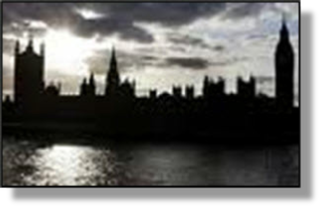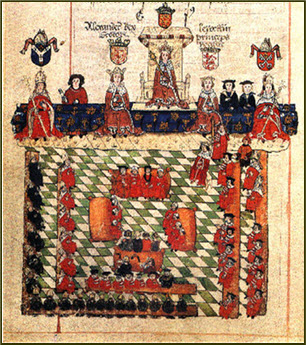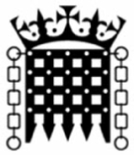


THE “MODEL PARLIAMENT” OF 1295 (E1)
xxxxxAs we have seen, in 1265 (H3), Simon de Montfort, having seized control of the government from Henry III (Edward’s father), formed the first semblance of a House of Commons, made up of representatives from the towns and knights of the shires. Thirty years later in 1295 Edward I took Montfort's assembly a step further. Named the Model Parliament, it included not only the aristocracy and higher clergy, but also representatives from the lower clergy and every shire, borough and city in the land -
 xxxxxWe have seen that, in the reign of Henry III, the king had been obliged to accept the Constitutions of Clarendon in 1258 and these had set up a committee of barons to oversee the running of the country. In 1265 (H3), however, Simon de Montfort, having gained control of the government from Henry III, took a decisive, albeit small step towards the establishment of parliamentary democracy. He formed what might be seen as the first semblance of a House of Commons, made up of representatives from the towns and knights of the shires. The experiment did not last long, and it was doubtless introduced simply to widen Montfort’s support against his enemies, but such an assembly had been called and thus a seed had been sown.
xxxxxWe have seen that, in the reign of Henry III, the king had been obliged to accept the Constitutions of Clarendon in 1258 and these had set up a committee of barons to oversee the running of the country. In 1265 (H3), however, Simon de Montfort, having gained control of the government from Henry III, took a decisive, albeit small step towards the establishment of parliamentary democracy. He formed what might be seen as the first semblance of a House of Commons, made up of representatives from the towns and knights of the shires. The experiment did not last long, and it was doubtless introduced simply to widen Montfort’s support against his enemies, but such an assembly had been called and thus a seed had been sown.
 xxxxxThe parliament set up by Edward I in 1295, thirty years later, took Montfort’s assembly a step further. Known as the Model Parliament, it was the first to include a wide range of representatives from outside the aristocracy and the higher clergy. It was comprised not only of earls, barons and bishops, for example, -
xxxxxThe parliament set up by Edward I in 1295, thirty years later, took Montfort’s assembly a step further. Known as the Model Parliament, it was the first to include a wide range of representatives from outside the aristocracy and the higher clergy. It was comprised not only of earls, barons and bishops, for example, -
xxxxxAgain, the reasons for the setting up of such an assembly had little if anything to do with democracy -
 xxxxxHowever, Edward’s parliament of 1295 did contain the essential elements of a workable and -
xxxxxHowever, Edward’s parliament of 1295 did contain the essential elements of a workable and -
E1-
Acknowledgement
Parliament: medieval manuscript thought to show Edward I presiding over parliament c1300 – contained in The Oxford Illustrated History of the British Monarchy, by John Cannon and Ralph A. Griffiths, published in Oxford in 1988, artist unknown.


